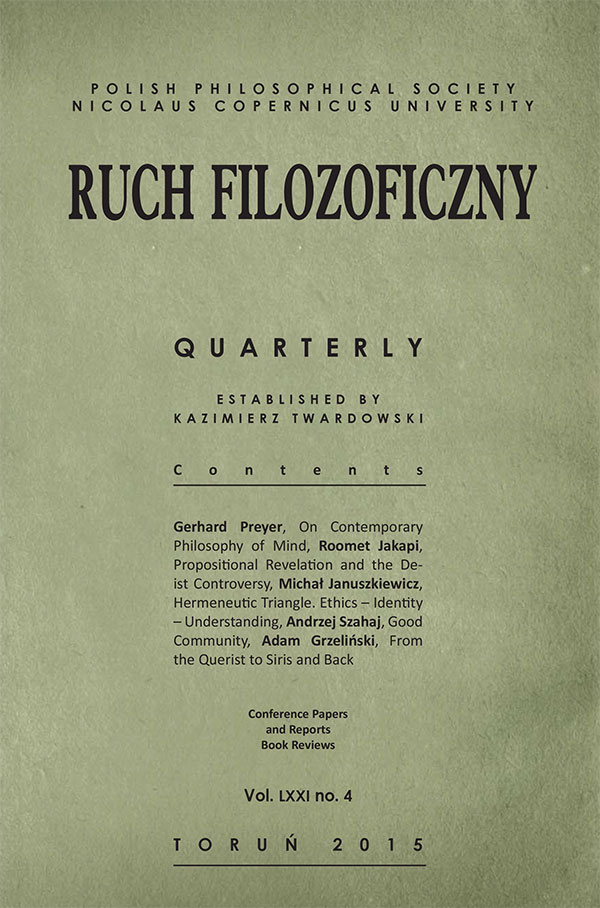The Role of Gesture in Verbal Communication
DOI:
https://doi.org/10.12775/RF.2015.003Słowa kluczowe
language, communication, verbal communication, gesture, language acquisition, learning processes, speech-gesture mismatchesAbstrakt
The paper focuses on the role of speech-gesture mismatches in both reading and producing verbal messages in different age groups. Starting from the review of ideas as to why human communication is so much different from the communication of other animals, it continues to show the role of gesture in relation to language acquisition and conveying meaning by children. The article also focuses on the way in which linguistic and non-linguistic information is represented and it deals with the subject of changes in reading gesture-based Communications in different age groups. Focusing mainly on speech-gesture mismatches, this paper expresses the importance of gesture in language development, learning and finally, understanding information conveyed by speech in adults and elders.
Bibliografia
Alibali, M. W., Kita, S., and Young, A. „Gesture and the process of speech production: We think, therefore we gesture”. In Language and Cognitive Processes, 15 (200), pp. 593-61.
Beauchamp, M.S., Lee, K.E., Argall, B.D., and Martin, A. „Integration of auditory and visual information about objects in superior temporal sulcus”. In Neuron, 41 (2004), pp. 809–823.
Beauchamp, M.S. „See me, hear me, touch me: multisensory integration in lateral occipital–temporal cortex”. In Current Opinion Neurobiology 15 (2005), pp. 145–153.
Bickerton, D. Language and species., pp. 114-122. Chicago: Chicago University Press, 1990.
Bowerman, M. „Learning the structure of causative verbs: a study in the relationship of cognitive, semantic and syntactic development”. Papers and Reports on Child Language Development, vol. 8, pp. 142-178, Stanford: Stanford University, 1974
Capirci, O., Montanari, S., and Volterra, V. „Gestures, signs, and words in early language development”. In The nature and functions of gesture in children’s Communications, edited by J. M. Iverson and S. Goldin-Meadow, pp. 45–60. San Francisco: Jossey-Bass, 1998
Carey, S. „The child as word learner”. In Linguistic Theory and Psychological Reality, edited by J. Bresnan, G. Miller and M. Halle, pp. 264-293. Cambridge, MA: MIT Press, 1978.
Cassell, J., McNeill, D., and McCullough, K. E. „Speech-gesture mismatches: Evidence for one underlying representation of linguistic and nonlinguistic information”. In Pragmatics and Cognition, 7 (1999), pp. 1-34.
Dunbar, R. Grooming, Gossip and the evolution of language. Faber and Faber, 1996.
Gärdenfors P. How homo became sapiens: the evolution of thinking, pp. 141-196. London: Oxford University Press, 2003.
Göksun, T., Hirsh-Pasek, K., & Golinkoff, R. M. „How do preschoolers express cause in gesture and speech?”. In Cognitive Development,25 (2010), Amsterdam: Elsevier.
Goldin-Meadow, S., and Butcher, C. „Pointing toward two word speech in young children”. In Pointing: Where language, culture, and cognition meet. edited by S. Kita, pp. 85–107. Psychology Press, 2003.
Goldin-Meadow, S., Nusbaum, H., Kelly, S. D., and Wagner, S. „Explaining math: gesturing lightens the load”. In Psychological Science, 12(2001), pp. 516–522.
Goldin-Meadow S. „The role of gesture in communication and thinking”. In Trends In Cognitive Science, 11 (1999), pp. 419-429.
Gómez, J, C. „Mutual awareness in primate communication: a Gricean approach”. In Self-awareness in animals and humans. Edited by Parker, S. T., Mitchell, R. W., and Boccia, M. L., p. 73. Cambridge: Cambridge University Press, 1994.
Gullberg, M., de Bot, K., and Volterra, V. „Gestures and some key issues in language development”. In Gesture, vol. 8, pp. 149-179. Amsterdam: John Benjamins, 2008
Hockett, C. „The Origin of Speech”. In Scientific American, 203 (1960), pp. 89-97.
Holcomb, P. „Semantic priming and stimulus degradation: Implications for the role of N400 in language processing”. In Psychophysiology, 30(1993), pp. 47–61.
Holle H., Gunter T.C., et al. „Neural correlates of the processing of co-speech gestures”. In NeuroImage, 39(2008), pp. 2010–2024.
Holler, J., Beattie, G. „Pragmatic aspects of representational gestures: do speakers use them to clarify verbal ambiguity for the listener?”. In Gesture, vol. 3, pp. 127–154. John Benjamins, 2003.
Iverson, J., and Goldin-Meadow, S. „Gesture paves the way for language development”. In Psychological Science, 16 (2005), pp. 367-371.
Kelly, S.D., Kravitz, C., and Hopkins, M. „Neural correlates of bimodal speech and gesture comprehension”. In Brain Language, 89 (2004), pp. 253–260.
Kidd, E., and Holler, J. „Children’s use of gesture to resolve lexical ambiguity”. In Developmental Science, 1 (2009), pp. 903-913.
Kita, S. „How representational gestures help speaking”. In Language and gesture: Window into thought and action, edited by D. McNeil, pp. 162–185. Cambridge, UK: Cambridge University Press, 2000.
Levelt, W.J.M., Richardson, G., and la Heij, W. „Pointing and voicing in deictic expressions”. In Journal of Memory and Language, 24 (1985), pp. 133–164.
Malinowski, B. „The Problem of Meaning in Primitive Languages”. In The Meaning of Meaning, edited by C. K. Ogden, and I. A. Richards, pp. 146-152, San Diego: A Harvest/HBJ Book, 1923.
McNeill, D. Hand and mind: What gestures reveal about thought. Chicago: University of Chicago Press, 1992.
Özçaliskan, S., and Goldin-Meadow, S. „Gesture is at the cutting edge of early language development”. In Cognition, 96 (2005), pp. B101 – B113.
Özçaliskan, S., and Goldin-Meadow, S. „When gesture-speech combinations do and do not index linguistic change”. In Language and Cognitive Processes, 24 (2009), pp. 190-217.
Rugg, M. D., and Coles, M. G. H. Electrophysiology of mind: Event-related brain potentials and cognition. London: Oxford University Press, 1995.
Sjölander, S. „Some cognitive breakthroughs in the evolution of cognition and consciousness, and their impact on the biology of language”. In Evolution and Cognition 3 (1993), pp. 5-6.
Wagner, S. M., Nusbaum, H., and Goldin-Meadow, S. „Probing the mental representation of gesture: is handwaving spatial”. In Journal of Memory and Language, 50 (2004), pp. 395–407.
Yorkston, K., Burgeois, M., and Baylor, C., „Communication and Aging”. In Physical Medicine & Rehabilitation Clinics of North America, 21 (2010), pp.309–319.
Pobrania
Opublikowane
Jak cytować
Numer
Dział
Statystyki
Liczba wyświetleń i pobrań: 618
Liczba cytowań: 0



